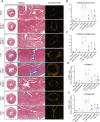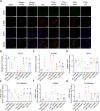Knockout RAGE alleviates cardiac fibrosis through repressing endothelial-to-mesenchymal transition (EndMT) mediated by autophagy
- PMID: 33976108
- PMCID: PMC8113558
- DOI: 10.1038/s41419-021-03750-4
Knockout RAGE alleviates cardiac fibrosis through repressing endothelial-to-mesenchymal transition (EndMT) mediated by autophagy
Abstract
Endothelial-to-mesenchymal transition (EndMT) has been shown to contribute to cardiac fibrosis and heart failure (HF). Recent studies have demonstrated that EndMT is regulated by autophagy, and we previously showed suppression of excessive autophagy and alleviation of cardiac fibrosis in HF mice with inactivated receptor for advanced glycation end products (RAGE). Thus, we investigated whether reduced cardiac fibrosis due to RAGE knockout occurred by inhibiting EndMT mediated by excessive autophagy. We found a decrease in endothelial cells (CD31+/VE-Cadherin+) and an increase in cells co-expressing CD31 and α-smooth muscle actin (α-SMA, myofibroblast marker) at 8 weeks in heart tissue of mice subjected to transverse aortic constriction (TAC), which implied EndMT. Knockout RAGE decreased EndMT accompanied by decreased expression of autophagy-related proteins (LC3BII/I and Beclin 1), and alleviated cardiac fibrosis and improved cardiac function in TAC mice. Moreover, 3-methyladenine (3-MA) and chloroquine (CQ), inhibitors of autophagy, attenuated EndMT, and cardiac fibrosis in TAC mice. Importantly, EndMT induced by AGEs could be blocked by autophagy inhibitor in vivo and in vitro. These results suggested that AGEs/RAGE-autophagy-EndMT axis involved in the development of cardiac fibrosis and knockout RAGE ameliorated cardiac fibrosis through decreasing EndMT regulated by autophagy, which could be a promising therapeutic strategy for HF.
Conflict of interest statement
The authors declare no competing interests.
Figures






Similar articles
-
Plantamajoside attenuates cardiac fibrosis via inhibiting AGEs activated-RAGE/autophagy/EndMT pathway.Phytother Res. 2023 Mar;37(3):834-847. doi: 10.1002/ptr.7663. Epub 2022 Nov 8. Phytother Res. 2023. PMID: 36349468
-
AGEs-RAGE axis mediates myocardial fibrosis via activation of cardiac fibroblasts induced by autophagy in heart failure.Exp Physiol. 2022 Aug;107(8):879-891. doi: 10.1113/EP090042. Epub 2022 Jun 2. Exp Physiol. 2022. PMID: 35598104
-
Macrophage RAGE deficiency prevents myocardial fibrosis by repressing autophagy-mediated macrophage alternative activation.FASEB J. 2023 Nov;37(11):e23259. doi: 10.1096/fj.202300173RR. FASEB J. 2023. PMID: 37855749
-
Epigenetic Regulation of Endothelial-to-Mesenchymal Transition in Chronic Heart Disease.Arterioscler Thromb Vasc Biol. 2018 Sep;38(9):1986-1996. doi: 10.1161/ATVBAHA.118.311276. Arterioscler Thromb Vasc Biol. 2018. PMID: 30354260 Review.
-
Endothelial-to-Mesenchymal Transition in Cardiovascular Pathophysiology.Int J Mol Sci. 2024 Jun 4;25(11):6180. doi: 10.3390/ijms25116180. Int J Mol Sci. 2024. PMID: 38892367 Free PMC article. Review.
Cited by
-
Pathophysiology of RAGE in inflammatory diseases.Front Immunol. 2022 Jul 29;13:931473. doi: 10.3389/fimmu.2022.931473. eCollection 2022. Front Immunol. 2022. PMID: 35967420 Free PMC article. Review.
-
Endothelial Reprogramming in Atherosclerosis.Bioengineering (Basel). 2024 Mar 27;11(4):325. doi: 10.3390/bioengineering11040325. Bioengineering (Basel). 2024. PMID: 38671747 Free PMC article. Review.
-
The role and mechanism of action of miR‑92a in endothelial cell autophagy.Mol Med Rep. 2024 Sep;30(3):172. doi: 10.3892/mmr.2024.13296. Epub 2024 Jul 26. Mol Med Rep. 2024. PMID: 39054957 Free PMC article.
-
The role of autophagy in the progression of HIV infected cardiomyopathy.Front Cell Dev Biol. 2024 Jul 17;12:1372573. doi: 10.3389/fcell.2024.1372573. eCollection 2024. Front Cell Dev Biol. 2024. PMID: 39086659 Free PMC article. Review.
-
Central role of cardiac fibroblasts in myocardial fibrosis of diabetic cardiomyopathy.Front Endocrinol (Lausanne). 2023 Mar 31;14:1162754. doi: 10.3389/fendo.2023.1162754. eCollection 2023. Front Endocrinol (Lausanne). 2023. PMID: 37065745 Free PMC article. Review.
References
-
- MacLean J, Pasumarthi KB. Signaling mechanisms regulating fibroblast activation, phenoconversion and fibrosis in the heart. Indian J. Biochem. Biophys. 2014;51:476–482. - PubMed
Publication types
MeSH terms
Substances
LinkOut - more resources
Full Text Sources
Other Literature Sources
Medical
Research Materials
Miscellaneous

